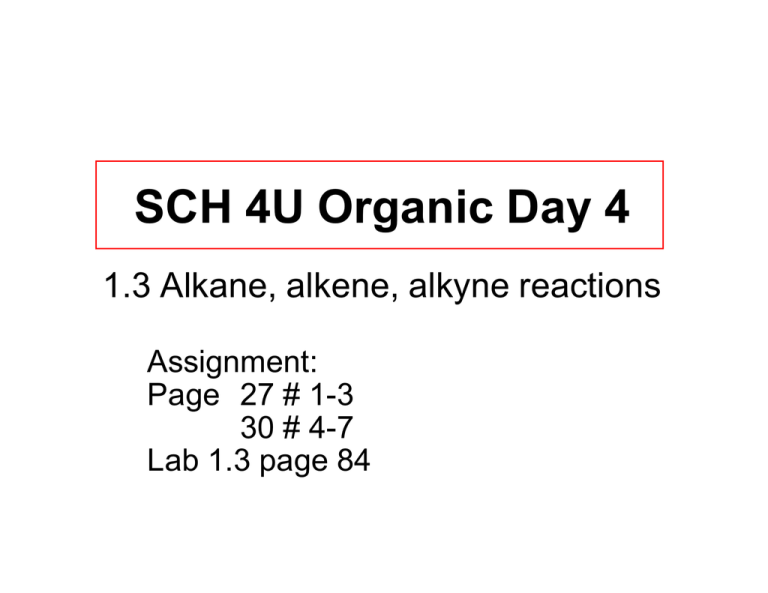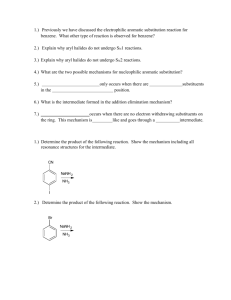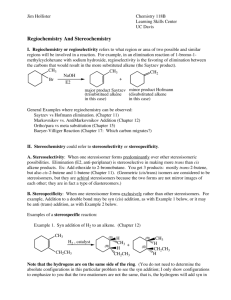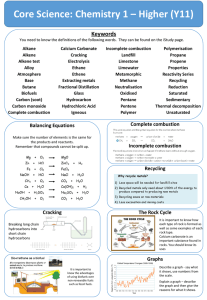SCH 4U Organic Day 4 1.3 Alkane, alkene, alkyne reactions Assignment:
advertisement

SCH 4U Organic Day 4 1.3 Alkane, alkene, alkyne reactions Assignment: Page 27 # 1-3 30 # 4-7 Lab 1.3 page 84 Learning Check Alk9 Select all correct names for each structure: Cl 1. Chlorocyclohexane 2. Chlorobenzene 3. 1-chlorobenzene CH 3 CH 3 1. Meta-methyltoluene 2. Meta-dimethylbenzene 3. 1,3-dimethylbenzene Solution Alk9 Select the names for each structure: Cl 2. Chlorobenzene CH3 1. Meta-methyltoluene 2. Meta-dimethylbenzene 3. 1,3-dimethylbenzene CH 3 Learning Check Alk10 Write the structural formulas for each of the following: A. 1,3-dichlorobenzene B. Ortho-chlorotoluene Solution Alk10 Write the structural formulas for each of the Cl following: A. 1,3-dichlorobenzene Cl CH 3 B. Ortho-chlorotoluene Cl ALKANE REACTIONS Reactions of Alkanes Combustion CH4 + 2O 2 CO2 + 2 H O + energy 2 Dehydrogenation RCH2 High Temp. catalyst CH2R RHC CHR alkene + H H Halogenation – radical substitution reactions light or heat + Br2 Br + HBr Combustion Reactions 5. Combustion Reactions • • Combustion reactions occur when a hydrocarbon reacts with oxygen gas. The 3 requirements for Combustion in the “fire triangle” are: 1) A Fuel (hydrocarbon) 2) Oxygen to burn it with 3) Heat to ignite the reaction (spark) Combustion Reactions • In general: CxHy + O2 à CO2 + H2O • Products in combustion are carbon dioxide and water (although incomplete combustion does cause some byproducts like carbon monoxide) Combustion is used to heat homes and run automobiles (octane, as in gasoline, is C 8H18) • Combustion Reactions Edgar Allen Poe's drooping eyes and mouth are potential signs of CO poisoning. www-cm ls.llnl.gov/?url=science_and_technology... Alkane Substitution Reactions P Organic reactions with alkanes are much slower than inorganic reactions (or alkene reactions) P Strong covalent bonds must be broken for organic reactions to occur P Replacing a hydrogen atom with some other atom (or atoms) is a substitution reaction P Alkyl halides are usually produced Halogenation H H H C C H H H + Heat or Light D or hv Br2 H Ethane C Heat or Light D or hv H H Methane + H C C H H Br + HBr Bromoethane H H H Cl2 H H C Cl + HCl H chloromethane CH2Cl2 and CHCl3 may be observed Substitution R eaction – a reaction in which part of a small reacting molecule replaces an atom or a group of atoms on the organic molecule (usually very slowly) BENZENE REACTIONS Benzene Substitution Reactions P Benzene does not contain double bonds due to delocalization of electrons P Strong covalent bonds must be broken for substitution reactions to occur in benzene P Slow substitution reactions can occur but no addition reactions occur with benzene HALOGENATION Cl2 , AlCl3 Cl Br2, FeBr3 Br Professor Charles Friedel and Professor James Crafts Br Br Br FeBr3 H + FeBr4 Reactions on Aromatic Rings: Substitution • Aromatic Substitution NO 2 H 2SO 4 reaction – Aromatic + H 2O + HNO 3 compound loses a hydrogen atom and another atom or group takes its place. NO 2 NO 2 NO 2 • It is possible for NO 2 substitution to occur in NO 2 more than one place on NO 2 ortho-Dinitrobenzene para-Dinitrobenzene meta-Dinitrobenzene the ring. ALKENE REACTIONS P The double covalent bond in an alkene is much easier to break than the single C-C bond P Addition reactions add across a double bond P Addition reactions occur much faster than substitution reactions Addition of Bromine to an Alkene Br R CH CH R + Br2 CCl4 or CH2Cl2 R CH CH Br R Bromine addition and Oxidation Reactions Hydrogenation of Alkenes Pt, Pd, R CH CH R + H2 or Ni R CH CH R H Also PtO2 -- sometimes Ru, Rh, or Re H Markovnikov’s Rule P Alkene addition reaction with H-X P The halogen (X) P H more often adds to the Carbon that has more H to begin with MARKOVNIKOV RULE PREDICTING THE MAJOR PRODUCT When adding HX to a double bond, the hydrogen of HX goes to the carbon which already has the most hydrogens CH 2 + HCl CH 3 Cl major product ..... conversely, the anion X adds to the most highly substituted carbon ( the carbon with most alkyl groups attached). AN “EMPIRICAL” RULE Markovnikoff formulated his rule by observing the results of hundreds of reactions that he performed. EMPIRICAL = DETERMINED BY OBSERVATION He had no idea why the reaction worked this way, only that as a general rule it did give the stated result. SOME ADDITIONAL EXAMPLES only major product is shown CH3 + HCl CH2 + HCl CH CH2 + HCl CH3 Cl CH3 Cl CH CH3 Cl Addition of Water to an Alkene R CH CH2 + H2O H2SO4 R CH CH2 H OH an alcohol MARKOVNIKOFF ADDITION ( HYDRATION REACTIONS, H 2 SO4 + H2 O ) CH 3 CH 3 H 2SO4 + H 2O OH CH 3 CH 2 H 2SO4 + H 2O H 2SO4 OH CH CH 2 CH CH 3 + H 2O OH ALKYNE REACTIONS – Alkene Hydrogenation C H C H Pt or Pd - catalyst solvent, pressure C H C H Double Hydrogenation for Alkynes C C 2X H H Pt - catalyst solvent, pressure H C H H C H Alkynes are more reactive in halogenation reactions than alkenes and can undergo 2 addition reactions Combustion Alkynes are high energy compounds H C C H + 2.5 O 2 “Acetylene” (Welding gas) 2 CO 2 + H 2O Addition Polymers Addition Polymers H H C C H H C C H H catalyst H H ethylene polyethylene a macromolecule with very high molecular weight Polymerization of propene H CH3 catalyst C C three different forms of “polypropylene” syndiotactic, isotactic and atactic H H CH3 CH3 CH3 C H3 isotactic CH3 CH3 CH3 CH3 syndiotactic








